PCAL 401205: Professional Communication in Nursing Case Study Essay
VerifiedAdded on 2022/09/25
|7
|1599
|15
Essay
AI Summary
This essay examines the critical role of effective communication in nursing, emphasizing its impact on patient safety and the development of therapeutic nurse-patient relationships. Using the case of Mr. George Pham, a 73-year-old baker, the essay explores the significance of both verbal and non-verbal communication skills in building trust and understanding patient needs. It highlights the importance of patient-centered care, where healthcare professionals must adapt their communication to the patient's individual needs and the role of documentation in maintaining accurate records and facilitating seamless care. The essay underscores how these three components—communication, person-centered care, and documentation—work in synergy to improve patient outcomes. The essay concludes that effective communication in nursing requires appropriate skills and knowledge and can lead to better treatment procedures.
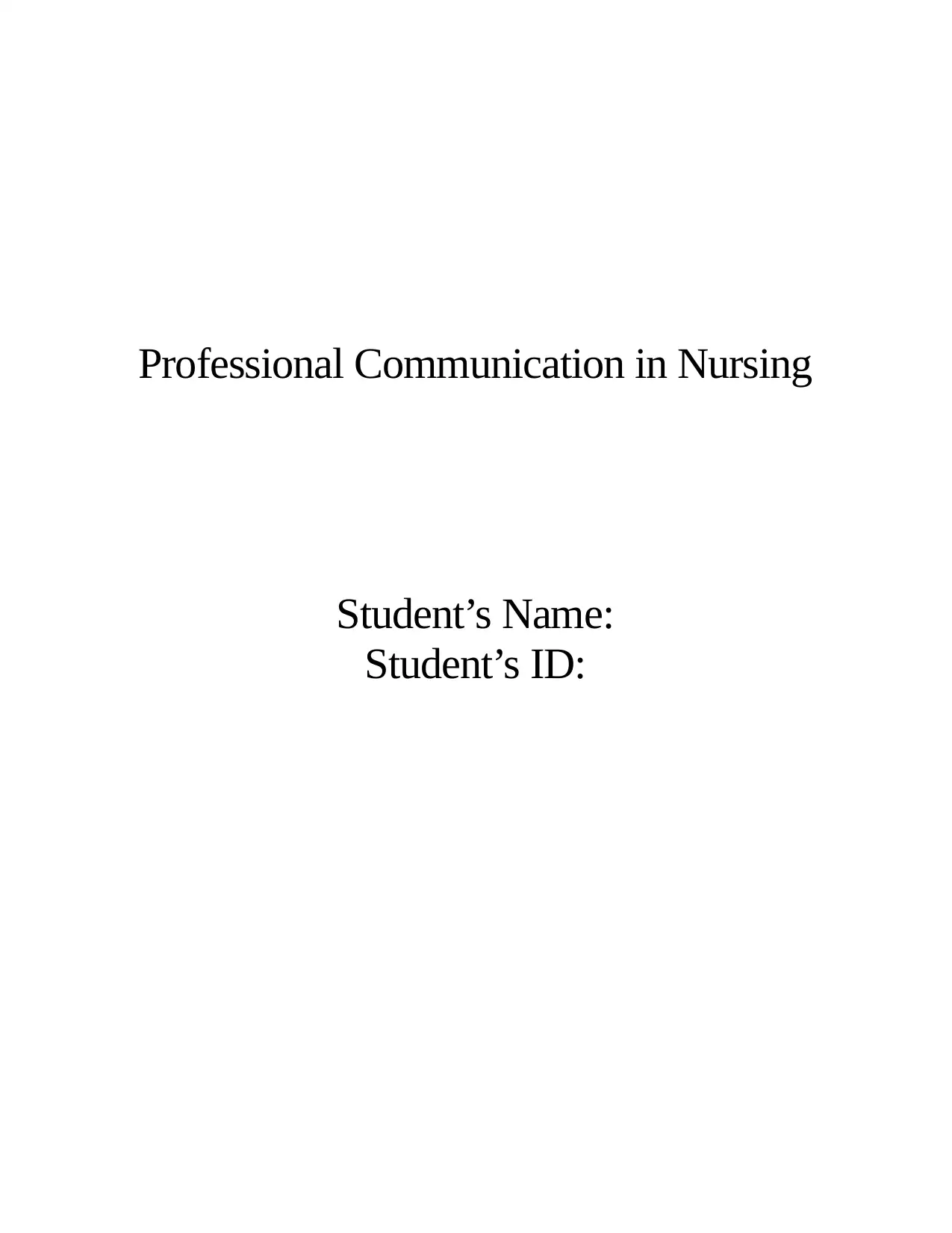
Professional Communication in Nursing
Student’s Name:
Student’s ID:
Student’s Name:
Student’s ID:
Paraphrase This Document
Need a fresh take? Get an instant paraphrase of this document with our AI Paraphraser
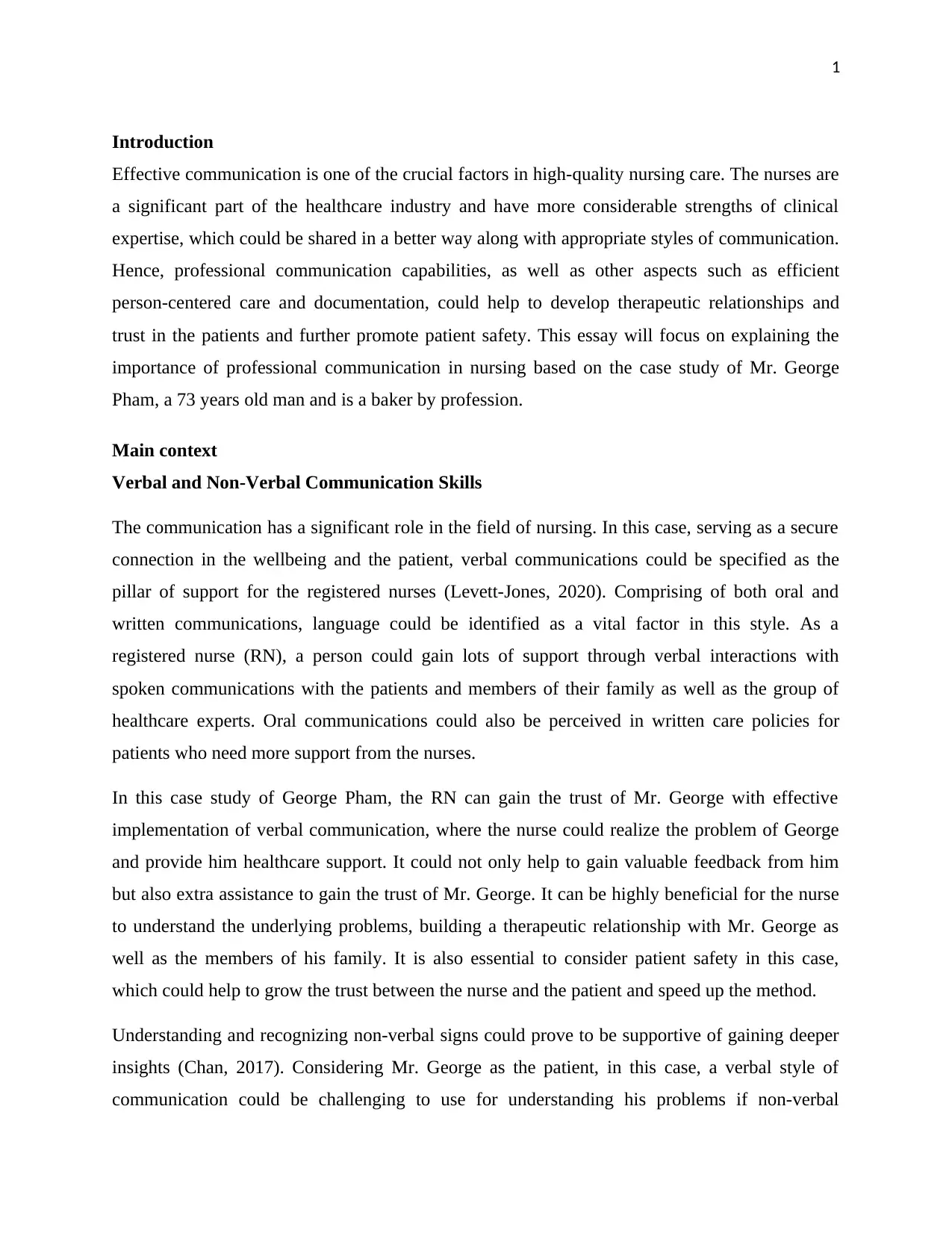
1
Introduction
Effective communication is one of the crucial factors in high-quality nursing care. The nurses are
a significant part of the healthcare industry and have more considerable strengths of clinical
expertise, which could be shared in a better way along with appropriate styles of communication.
Hence, professional communication capabilities, as well as other aspects such as efficient
person-centered care and documentation, could help to develop therapeutic relationships and
trust in the patients and further promote patient safety. This essay will focus on explaining the
importance of professional communication in nursing based on the case study of Mr. George
Pham, a 73 years old man and is a baker by profession.
Main context
Verbal and Non-Verbal Communication Skills
The communication has a significant role in the field of nursing. In this case, serving as a secure
connection in the wellbeing and the patient, verbal communications could be specified as the
pillar of support for the registered nurses (Levett-Jones, 2020). Comprising of both oral and
written communications, language could be identified as a vital factor in this style. As a
registered nurse (RN), a person could gain lots of support through verbal interactions with
spoken communications with the patients and members of their family as well as the group of
healthcare experts. Oral communications could also be perceived in written care policies for
patients who need more support from the nurses.
In this case study of George Pham, the RN can gain the trust of Mr. George with effective
implementation of verbal communication, where the nurse could realize the problem of George
and provide him healthcare support. It could not only help to gain valuable feedback from him
but also extra assistance to gain the trust of Mr. George. It can be highly beneficial for the nurse
to understand the underlying problems, building a therapeutic relationship with Mr. George as
well as the members of his family. It is also essential to consider patient safety in this case,
which could help to grow the trust between the nurse and the patient and speed up the method.
Understanding and recognizing non-verbal signs could prove to be supportive of gaining deeper
insights (Chan, 2017). Considering Mr. George as the patient, in this case, a verbal style of
communication could be challenging to use for understanding his problems if non-verbal
Introduction
Effective communication is one of the crucial factors in high-quality nursing care. The nurses are
a significant part of the healthcare industry and have more considerable strengths of clinical
expertise, which could be shared in a better way along with appropriate styles of communication.
Hence, professional communication capabilities, as well as other aspects such as efficient
person-centered care and documentation, could help to develop therapeutic relationships and
trust in the patients and further promote patient safety. This essay will focus on explaining the
importance of professional communication in nursing based on the case study of Mr. George
Pham, a 73 years old man and is a baker by profession.
Main context
Verbal and Non-Verbal Communication Skills
The communication has a significant role in the field of nursing. In this case, serving as a secure
connection in the wellbeing and the patient, verbal communications could be specified as the
pillar of support for the registered nurses (Levett-Jones, 2020). Comprising of both oral and
written communications, language could be identified as a vital factor in this style. As a
registered nurse (RN), a person could gain lots of support through verbal interactions with
spoken communications with the patients and members of their family as well as the group of
healthcare experts. Oral communications could also be perceived in written care policies for
patients who need more support from the nurses.
In this case study of George Pham, the RN can gain the trust of Mr. George with effective
implementation of verbal communication, where the nurse could realize the problem of George
and provide him healthcare support. It could not only help to gain valuable feedback from him
but also extra assistance to gain the trust of Mr. George. It can be highly beneficial for the nurse
to understand the underlying problems, building a therapeutic relationship with Mr. George as
well as the members of his family. It is also essential to consider patient safety in this case,
which could help to grow the trust between the nurse and the patient and speed up the method.
Understanding and recognizing non-verbal signs could prove to be supportive of gaining deeper
insights (Chan, 2017). Considering Mr. George as the patient, in this case, a verbal style of
communication could be challenging to use for understanding his problems if non-verbal
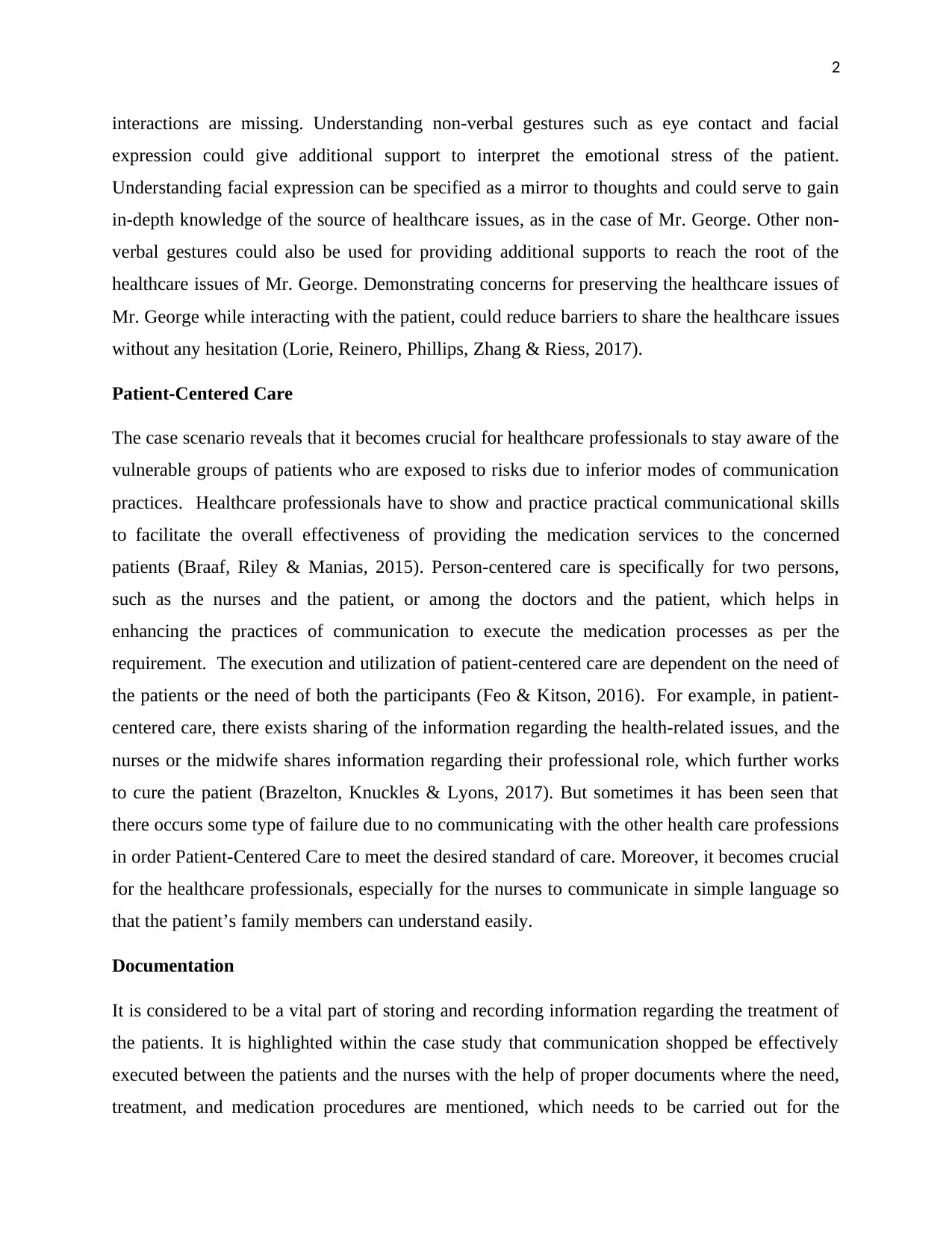
2
interactions are missing. Understanding non-verbal gestures such as eye contact and facial
expression could give additional support to interpret the emotional stress of the patient.
Understanding facial expression can be specified as a mirror to thoughts and could serve to gain
in-depth knowledge of the source of healthcare issues, as in the case of Mr. George. Other non-
verbal gestures could also be used for providing additional supports to reach the root of the
healthcare issues of Mr. George. Demonstrating concerns for preserving the healthcare issues of
Mr. George while interacting with the patient, could reduce barriers to share the healthcare issues
without any hesitation (Lorie, Reinero, Phillips, Zhang & Riess, 2017).
Patient-Centered Care
The case scenario reveals that it becomes crucial for healthcare professionals to stay aware of the
vulnerable groups of patients who are exposed to risks due to inferior modes of communication
practices. Healthcare professionals have to show and practice practical communicational skills
to facilitate the overall effectiveness of providing the medication services to the concerned
patients (Braaf, Riley & Manias, 2015). Person-centered care is specifically for two persons,
such as the nurses and the patient, or among the doctors and the patient, which helps in
enhancing the practices of communication to execute the medication processes as per the
requirement. The execution and utilization of patient-centered care are dependent on the need of
the patients or the need of both the participants (Feo & Kitson, 2016). For example, in patient-
centered care, there exists sharing of the information regarding the health-related issues, and the
nurses or the midwife shares information regarding their professional role, which further works
to cure the patient (Brazelton, Knuckles & Lyons, 2017). But sometimes it has been seen that
there occurs some type of failure due to no communicating with the other health care professions
in order Patient-Centered Care to meet the desired standard of care. Moreover, it becomes crucial
for the healthcare professionals, especially for the nurses to communicate in simple language so
that the patient’s family members can understand easily.
Documentation
It is considered to be a vital part of storing and recording information regarding the treatment of
the patients. It is highlighted within the case study that communication shopped be effectively
executed between the patients and the nurses with the help of proper documents where the need,
treatment, and medication procedures are mentioned, which needs to be carried out for the
interactions are missing. Understanding non-verbal gestures such as eye contact and facial
expression could give additional support to interpret the emotional stress of the patient.
Understanding facial expression can be specified as a mirror to thoughts and could serve to gain
in-depth knowledge of the source of healthcare issues, as in the case of Mr. George. Other non-
verbal gestures could also be used for providing additional supports to reach the root of the
healthcare issues of Mr. George. Demonstrating concerns for preserving the healthcare issues of
Mr. George while interacting with the patient, could reduce barriers to share the healthcare issues
without any hesitation (Lorie, Reinero, Phillips, Zhang & Riess, 2017).
Patient-Centered Care
The case scenario reveals that it becomes crucial for healthcare professionals to stay aware of the
vulnerable groups of patients who are exposed to risks due to inferior modes of communication
practices. Healthcare professionals have to show and practice practical communicational skills
to facilitate the overall effectiveness of providing the medication services to the concerned
patients (Braaf, Riley & Manias, 2015). Person-centered care is specifically for two persons,
such as the nurses and the patient, or among the doctors and the patient, which helps in
enhancing the practices of communication to execute the medication processes as per the
requirement. The execution and utilization of patient-centered care are dependent on the need of
the patients or the need of both the participants (Feo & Kitson, 2016). For example, in patient-
centered care, there exists sharing of the information regarding the health-related issues, and the
nurses or the midwife shares information regarding their professional role, which further works
to cure the patient (Brazelton, Knuckles & Lyons, 2017). But sometimes it has been seen that
there occurs some type of failure due to no communicating with the other health care professions
in order Patient-Centered Care to meet the desired standard of care. Moreover, it becomes crucial
for the healthcare professionals, especially for the nurses to communicate in simple language so
that the patient’s family members can understand easily.
Documentation
It is considered to be a vital part of storing and recording information regarding the treatment of
the patients. It is highlighted within the case study that communication shopped be effectively
executed between the patients and the nurses with the help of proper documents where the need,
treatment, and medication procedures are mentioned, which needs to be carried out for the
⊘ This is a preview!⊘
Do you want full access?
Subscribe today to unlock all pages.

Trusted by 1+ million students worldwide
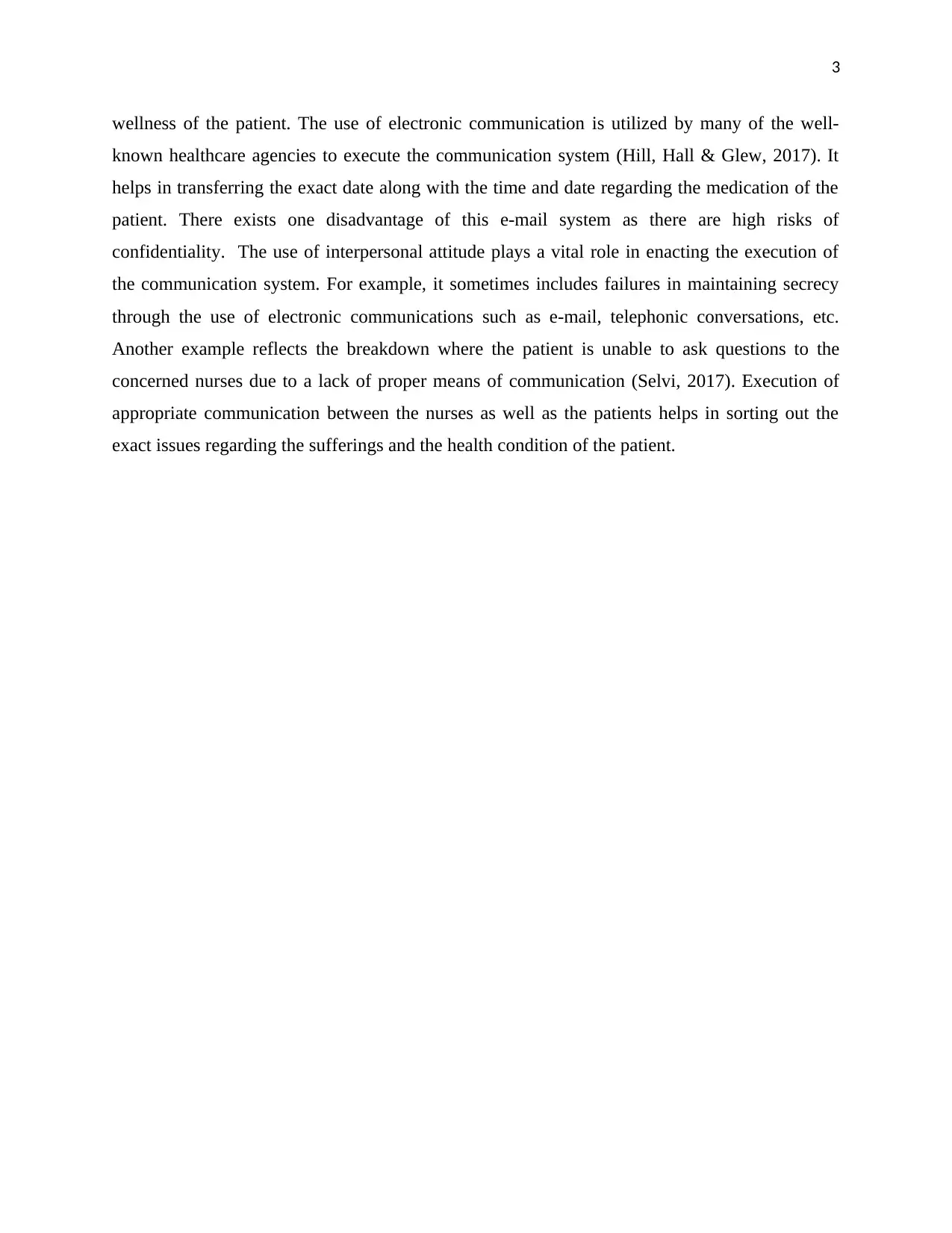
3
wellness of the patient. The use of electronic communication is utilized by many of the well-
known healthcare agencies to execute the communication system (Hill, Hall & Glew, 2017). It
helps in transferring the exact date along with the time and date regarding the medication of the
patient. There exists one disadvantage of this e-mail system as there are high risks of
confidentiality. The use of interpersonal attitude plays a vital role in enacting the execution of
the communication system. For example, it sometimes includes failures in maintaining secrecy
through the use of electronic communications such as e-mail, telephonic conversations, etc.
Another example reflects the breakdown where the patient is unable to ask questions to the
concerned nurses due to a lack of proper means of communication (Selvi, 2017). Execution of
appropriate communication between the nurses as well as the patients helps in sorting out the
exact issues regarding the sufferings and the health condition of the patient.
wellness of the patient. The use of electronic communication is utilized by many of the well-
known healthcare agencies to execute the communication system (Hill, Hall & Glew, 2017). It
helps in transferring the exact date along with the time and date regarding the medication of the
patient. There exists one disadvantage of this e-mail system as there are high risks of
confidentiality. The use of interpersonal attitude plays a vital role in enacting the execution of
the communication system. For example, it sometimes includes failures in maintaining secrecy
through the use of electronic communications such as e-mail, telephonic conversations, etc.
Another example reflects the breakdown where the patient is unable to ask questions to the
concerned nurses due to a lack of proper means of communication (Selvi, 2017). Execution of
appropriate communication between the nurses as well as the patients helps in sorting out the
exact issues regarding the sufferings and the health condition of the patient.
Paraphrase This Document
Need a fresh take? Get an instant paraphrase of this document with our AI Paraphraser
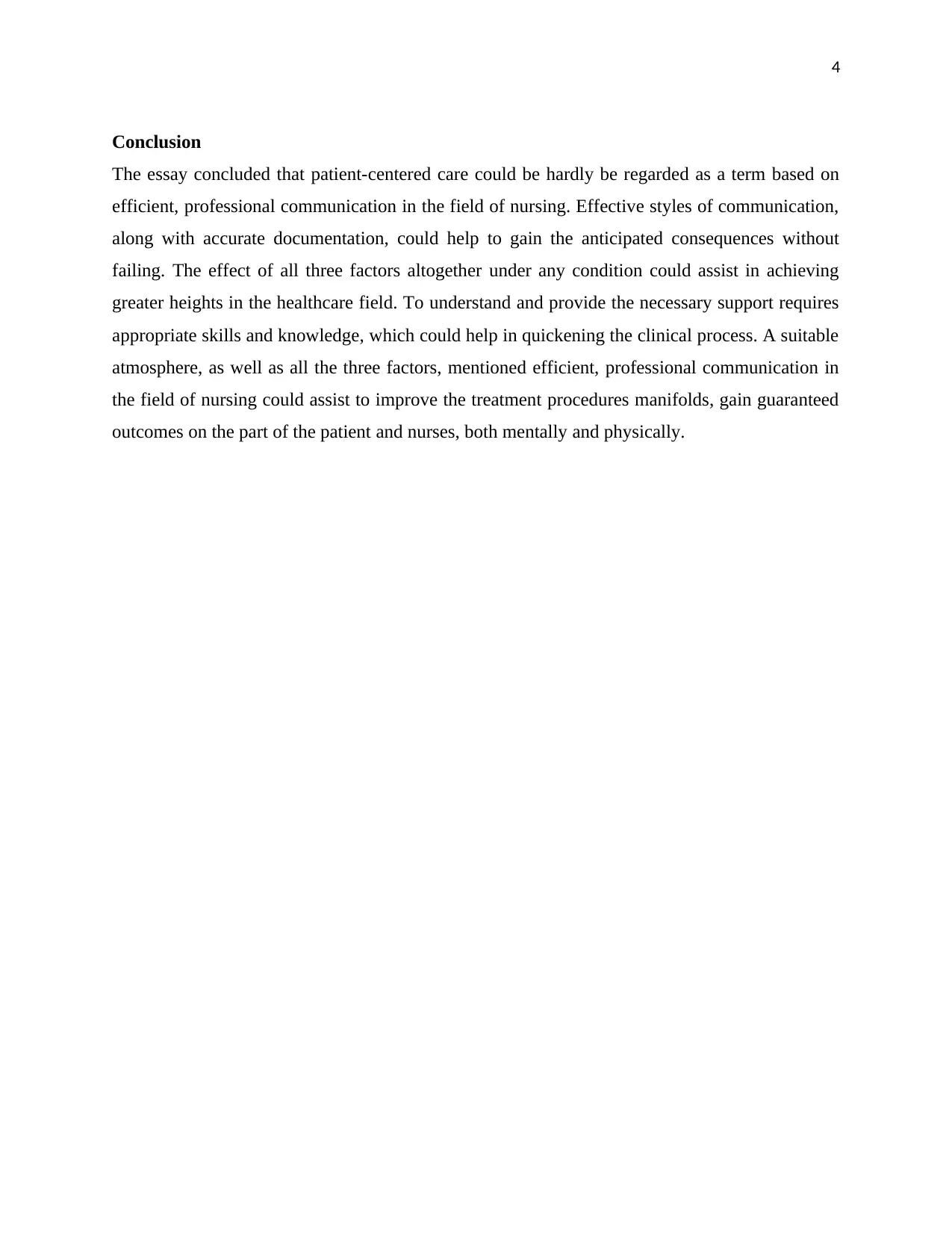
4
Conclusion
The essay concluded that patient-centered care could be hardly be regarded as a term based on
efficient, professional communication in the field of nursing. Effective styles of communication,
along with accurate documentation, could help to gain the anticipated consequences without
failing. The effect of all three factors altogether under any condition could assist in achieving
greater heights in the healthcare field. To understand and provide the necessary support requires
appropriate skills and knowledge, which could help in quickening the clinical process. A suitable
atmosphere, as well as all the three factors, mentioned efficient, professional communication in
the field of nursing could assist to improve the treatment procedures manifolds, gain guaranteed
outcomes on the part of the patient and nurses, both mentally and physically.
Conclusion
The essay concluded that patient-centered care could be hardly be regarded as a term based on
efficient, professional communication in the field of nursing. Effective styles of communication,
along with accurate documentation, could help to gain the anticipated consequences without
failing. The effect of all three factors altogether under any condition could assist in achieving
greater heights in the healthcare field. To understand and provide the necessary support requires
appropriate skills and knowledge, which could help in quickening the clinical process. A suitable
atmosphere, as well as all the three factors, mentioned efficient, professional communication in
the field of nursing could assist to improve the treatment procedures manifolds, gain guaranteed
outcomes on the part of the patient and nurses, both mentally and physically.
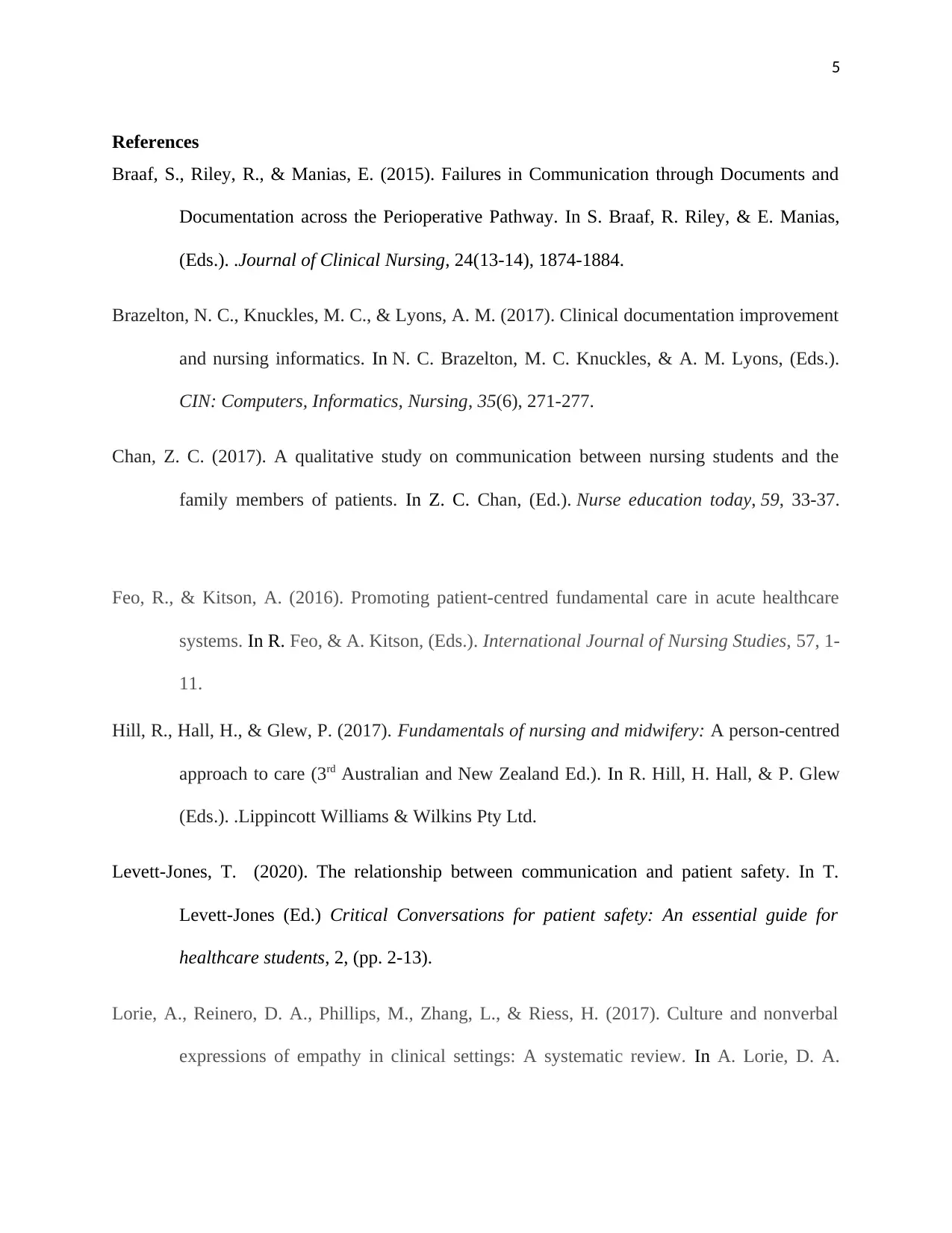
5
References
Braaf, S., Riley, R., & Manias, E. (2015). Failures in Communication through Documents and
Documentation across the Perioperative Pathway. In S. Braaf, R. Riley, & E. Manias,
(Eds.). .Journal of Clinical Nursing, 24(13-14), 1874-1884.
Brazelton, N. C., Knuckles, M. C., & Lyons, A. M. (2017). Clinical documentation improvement
and nursing informatics. In N. C. Brazelton, M. C. Knuckles, & A. M. Lyons, (Eds.).
CIN: Computers, Informatics, Nursing, 35(6), 271-277.
Chan, Z. C. (2017). A qualitative study on communication between nursing students and the
family members of patients. In Z. C. Chan, (Ed.). Nurse education today, 59, 33-37.
Feo, R., & Kitson, A. (2016). Promoting patient-centred fundamental care in acute healthcare
systems. In R. Feo, & A. Kitson, (Eds.). International Journal of Nursing Studies, 57, 1-
11.
Hill, R., Hall, H., & Glew, P. (2017). Fundamentals of nursing and midwifery: A person-centred
approach to care (3rd Australian and New Zealand Ed.). In R. Hill, H. Hall, & P. Glew
(Eds.). .Lippincott Williams & Wilkins Pty Ltd.
Levett-Jones, T. (2020). The relationship between communication and patient safety. In T.
Levett-Jones (Ed.) Critical Conversations for patient safety: An essential guide for
healthcare students, 2, (pp. 2-13).
Lorie, A., Reinero, D. A., Phillips, M., Zhang, L., & Riess, H. (2017). Culture and nonverbal
expressions of empathy in clinical settings: A systematic review. In A. Lorie, D. A.
References
Braaf, S., Riley, R., & Manias, E. (2015). Failures in Communication through Documents and
Documentation across the Perioperative Pathway. In S. Braaf, R. Riley, & E. Manias,
(Eds.). .Journal of Clinical Nursing, 24(13-14), 1874-1884.
Brazelton, N. C., Knuckles, M. C., & Lyons, A. M. (2017). Clinical documentation improvement
and nursing informatics. In N. C. Brazelton, M. C. Knuckles, & A. M. Lyons, (Eds.).
CIN: Computers, Informatics, Nursing, 35(6), 271-277.
Chan, Z. C. (2017). A qualitative study on communication between nursing students and the
family members of patients. In Z. C. Chan, (Ed.). Nurse education today, 59, 33-37.
Feo, R., & Kitson, A. (2016). Promoting patient-centred fundamental care in acute healthcare
systems. In R. Feo, & A. Kitson, (Eds.). International Journal of Nursing Studies, 57, 1-
11.
Hill, R., Hall, H., & Glew, P. (2017). Fundamentals of nursing and midwifery: A person-centred
approach to care (3rd Australian and New Zealand Ed.). In R. Hill, H. Hall, & P. Glew
(Eds.). .Lippincott Williams & Wilkins Pty Ltd.
Levett-Jones, T. (2020). The relationship between communication and patient safety. In T.
Levett-Jones (Ed.) Critical Conversations for patient safety: An essential guide for
healthcare students, 2, (pp. 2-13).
Lorie, A., Reinero, D. A., Phillips, M., Zhang, L., & Riess, H. (2017). Culture and nonverbal
expressions of empathy in clinical settings: A systematic review. In A. Lorie, D. A.
⊘ This is a preview!⊘
Do you want full access?
Subscribe today to unlock all pages.

Trusted by 1+ million students worldwide
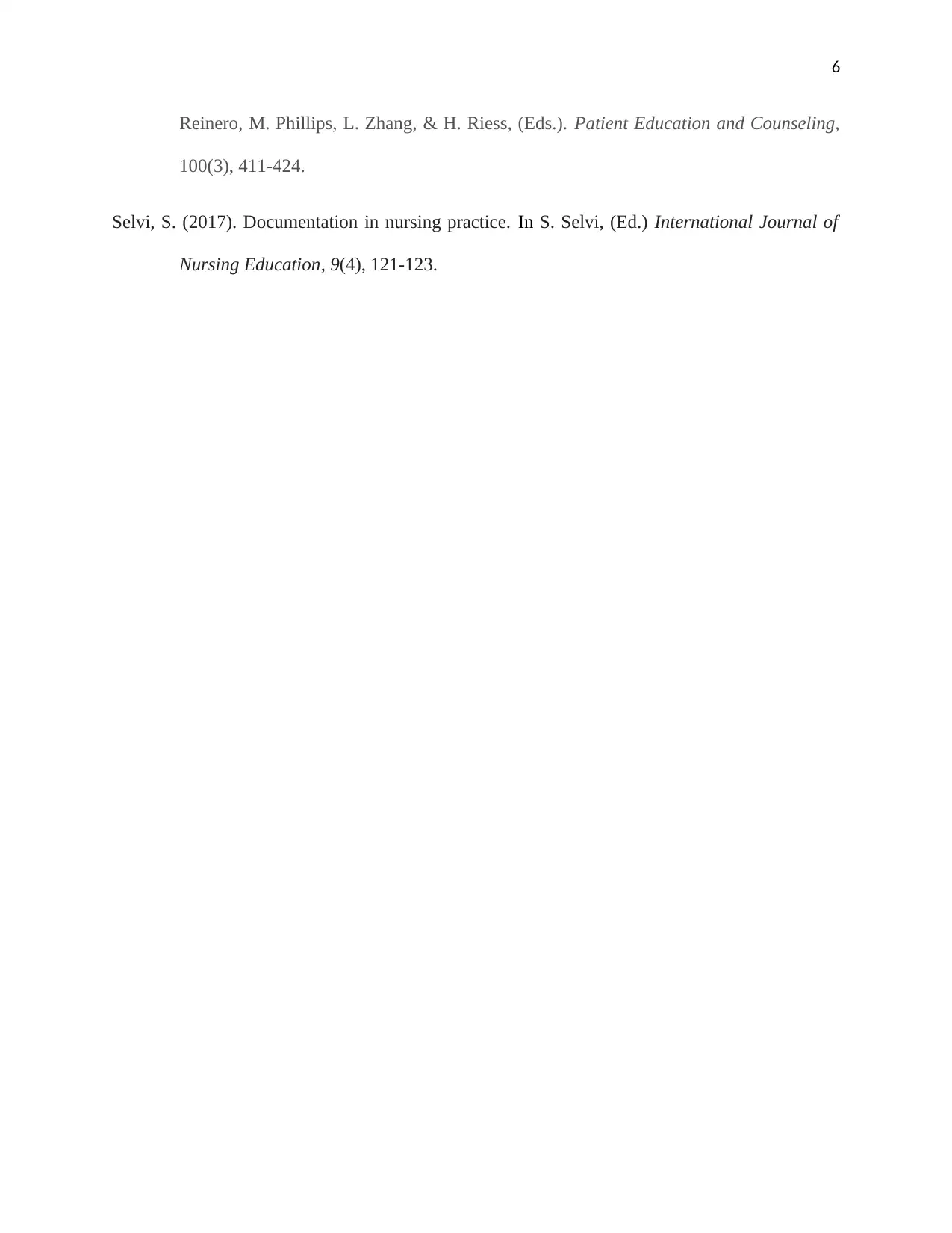
6
Reinero, M. Phillips, L. Zhang, & H. Riess, (Eds.). Patient Education and Counseling,
100(3), 411-424.
Selvi, S. (2017). Documentation in nursing practice. In S. Selvi, (Ed.) International Journal of
Nursing Education, 9(4), 121-123.
Reinero, M. Phillips, L. Zhang, & H. Riess, (Eds.). Patient Education and Counseling,
100(3), 411-424.
Selvi, S. (2017). Documentation in nursing practice. In S. Selvi, (Ed.) International Journal of
Nursing Education, 9(4), 121-123.
1 out of 7
Related Documents
Your All-in-One AI-Powered Toolkit for Academic Success.
+13062052269
info@desklib.com
Available 24*7 on WhatsApp / Email
![[object Object]](/_next/static/media/star-bottom.7253800d.svg)
Unlock your academic potential
Copyright © 2020–2025 A2Z Services. All Rights Reserved. Developed and managed by ZUCOL.





